Technology permeates all aspects of modern society, from using social media to communicate with friends to relying on machine automation for mundane tasks. As an integral part of our everyday lives, technology drives how we live, work, and interact with each other – this includes the emergence of new technology woven into our social lives. These combinations of social elements interacting with technology are called a socio-technical system (STS). Despite being at the centre of our daily routines, not many people know about them or the effect they will have on our future technologies. This article presents a (very) brief introduction to the broad subject of socio-technical systems and how approaching our interactions with technology from a holistic viewpoint allows us to design better for our futures.
Essentially, the aim of an STS is to bring people and technology together to achieve a common goal or purpose. Social media platforms are an example of a modern STS allowing people to communicate via technical software, algorithms, and data analysis. Other well-known examples include email, E-commerce systems (e.g. Amazon and eBay), modern healthcare databases, transportation systems such as logistics, public transport or ridesharing, and energy grids that many of us rely on for electricity.
The first ideas of the STS were developed in the mid-20th Century to understand the growing complexity and interdependence between people, machines, organisations, and their environments in industries like mining, manufacturing, and agriculture. This socio-technical theory revolutionised modern society by increasing connectivity, transforming how work is performed, and disrupting traditional industries. They have changed consumer behaviour and increased dependence on technology, leading to new opportunities and challenges for individuals and organisations.
Currently, the concept of STSs often draws upon design philosophies that recognise the social and technical parts but still regard the system holistically as symbiotic, i.e. each system element should benefit from its interaction with another element. Design approaches and problem-solving techniques, such as human-centred design (HCD), cover a broad context that includes a system’s human, social, technological, and environmental aspects. In this approach, the design process starts with understanding the human users’ needs, wants, and limitations and then incorporates these into the design of the technology. Ultimately HCD provides us with a toolkit that optimises STS interactions to achieve a better outcome and to produce an effective system. The goal is to create a system that supports and augments human capabilities while also meeting technical requirements, resulting in a solution that is both efficient and user-friendly. This approach is commonly used in fields such as ergonomics, user experience (UX), human-computer interaction (HCI), and collaborative robotics (aka cobotics) – where the interaction between humans and technology is critical to the success of the system.
In robotics, STSs have significantly impacted robot development and deployment, especially in collaborative environments shared between people and robots. Cloud computing, Internet-of-Things (IoT) connectivity, and remote collaboration tools have enabled faster and more efficient robotics development by allowing experts to work together on projects regardless of their location. The vast amounts of data generated by these systems have advanced artificial intelligence and machine learning technologies, making robots more autonomous, interactive, and gradually capable of increasingly complex tasks. The ease of access to robotics technology via STS approaches has increased adoption, particularly in manufacturing, where robots traditionally automate repetitive tasks – but are now envisioned to assist with more complex labour tasks. Interaction between humans and robots has also been impacted by STSs, with new methods such as natural language processing, mixed-reality interfaces, and voice or gesture commands being developed to enable more seamless and intuitive human-robot interaction.
However, here lies one central challenge – balancing technical components against social ones often proves difficult. Finding the correct ratio that can meet various goals, like promoting efficiency while maintaining human responsibility, adds complexity towards overall issues such as community involvement, a person’s health, and the environment. It is essential for organisations to carefully consider the ethical and safety implications of collaboration between humans and robots before implementing them. STSs effectively create solutions that work well and consider social aspects such as ethics or user experience. By combining technical elements with social ones – robots with humans – we balance what is technically possible and socially acceptable, creating something beneficial for everyone involved. The goal of this combination isn’t just efficiency but rather something that can be used safely while being more productive than ever before. That is why including human-centred factors is paramount to achieving correct integration and guarantees excellent outcomes for everyone.
In summary, human-robot collaboration in socio-technical systems can bring several benefits, including increased efficiency, improved safety, enhanced productivity, better outcomes, and cost savings. However, it is important to consider this collaboration’s ethical and safety implications to ensure it is used responsibly. Future technological developments will bring challenges and opportunities for organisations involved in human-robot collaboration within socio-technical systems. It is up to these organisations to carefully consider the implications of their actions and strive towards creating effective and socially acceptable solutions.

